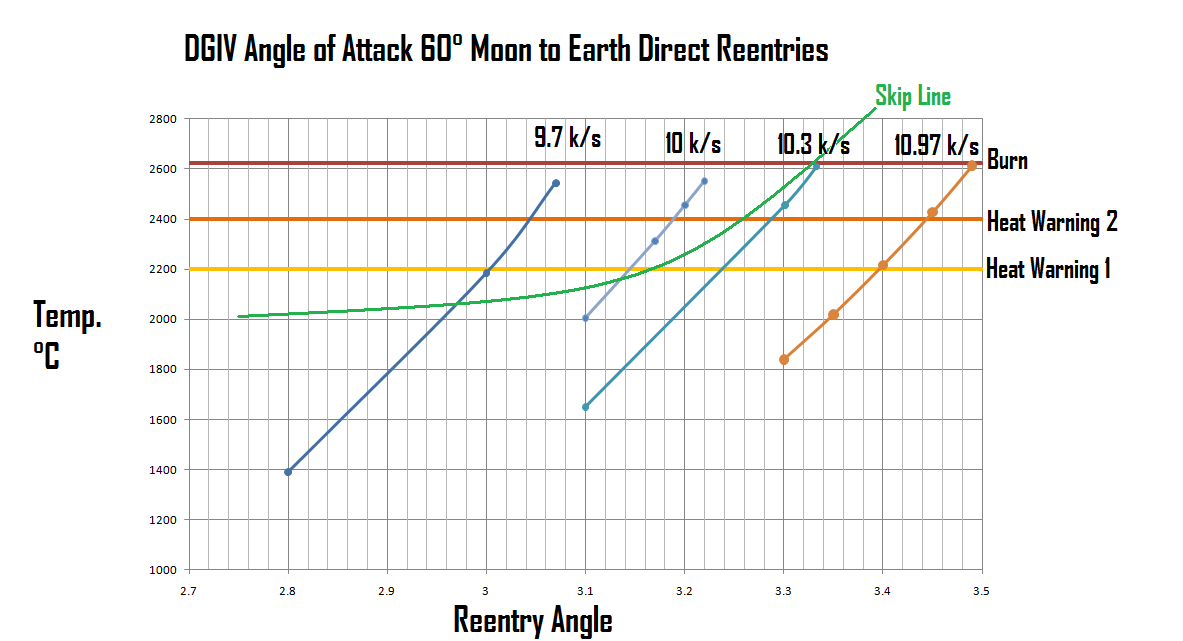Burnrate
New member
- Joined
- Aug 15, 2009
- Messages
- 8
- Reaction score
- 0
- Points
- 0
I made a little chart giving a general idea of how the DG-IV can survive doing a direct reentry into the Earth's atmosphere and how you can get the result you want. The main benefit of this is saving fuel so and time so you don't have to reduce the eccentricity of your orbit.

This shows the different maximum temperature reached against what your reentry angle is. Each curve is a different reentry speed. All data was taken from the second and third display of the DG-IV. All entries were made just below the maximum allowable weight
The angle of attack was set at 60 degrees using the DG-IV program 104 spec 7. This gave me the best chance of slowing down and not shooting back off into the atmosphere. It also gave me the best chance of burning up before I had this chart.
The skip line is not very accurate and shaped based on my intuition. It is 'about' right though and can be used with a margin of error. What it tells you is that if your reentry parameters fall below the skip line you will 'skip' off the earths atmosphere and have to come around for another pass.
(You could plot accurate skip curves for each skip altitude to know exactly how high you would go but that would require a lot more data points.)
This means the approximate maximum speed you could be going and aerobrake in one pass is about 10.2 km/s with a reentry angle of about 3.29 degrees.
It is pretty easy to interpolate to find a good reentry angle for whatever speed you may be going. The higher speeds may skip you back into orbit but it is good to know a reentry angle which will give you maximum braking effect. (Remember you don't always need go up to 2600 degrees!)
This is a little diagram which shows a good way to lower your reentry velocity about 1 km/s or so while maintaining a reentry angle. I usually take care of this while at about 10M altitude and fine tune my reentry angle at around 3M. This will not take you off track of your base if you are already lined up over it. (Be careful to keep the dV in the orbit plane.)


This shows the different maximum temperature reached against what your reentry angle is. Each curve is a different reentry speed. All data was taken from the second and third display of the DG-IV. All entries were made just below the maximum allowable weight
The angle of attack was set at 60 degrees using the DG-IV program 104 spec 7. This gave me the best chance of slowing down and not shooting back off into the atmosphere. It also gave me the best chance of burning up before I had this chart.
The skip line is not very accurate and shaped based on my intuition. It is 'about' right though and can be used with a margin of error. What it tells you is that if your reentry parameters fall below the skip line you will 'skip' off the earths atmosphere and have to come around for another pass.
(You could plot accurate skip curves for each skip altitude to know exactly how high you would go but that would require a lot more data points.)
This means the approximate maximum speed you could be going and aerobrake in one pass is about 10.2 km/s with a reentry angle of about 3.29 degrees.
It is pretty easy to interpolate to find a good reentry angle for whatever speed you may be going. The higher speeds may skip you back into orbit but it is good to know a reentry angle which will give you maximum braking effect. (Remember you don't always need go up to 2600 degrees!)
This is a little diagram which shows a good way to lower your reentry velocity about 1 km/s or so while maintaining a reentry angle. I usually take care of this while at about 10M altitude and fine tune my reentry angle at around 3M. This will not take you off track of your base if you are already lined up over it. (Be careful to keep the dV in the orbit plane.)

Last edited:


